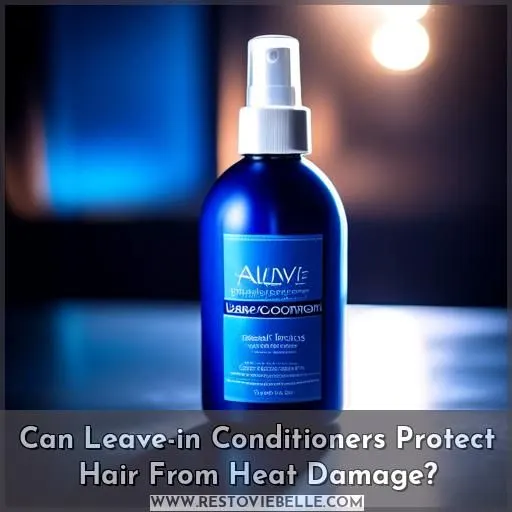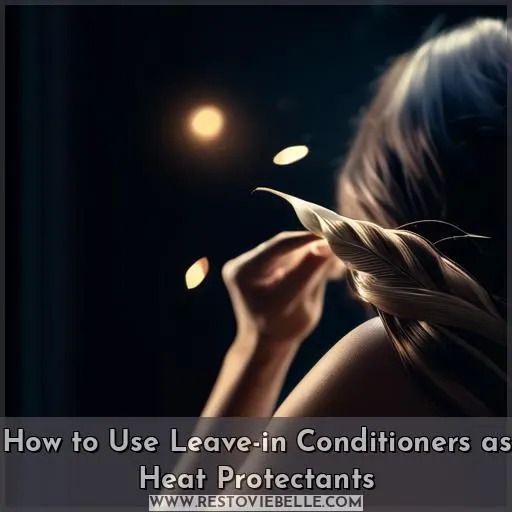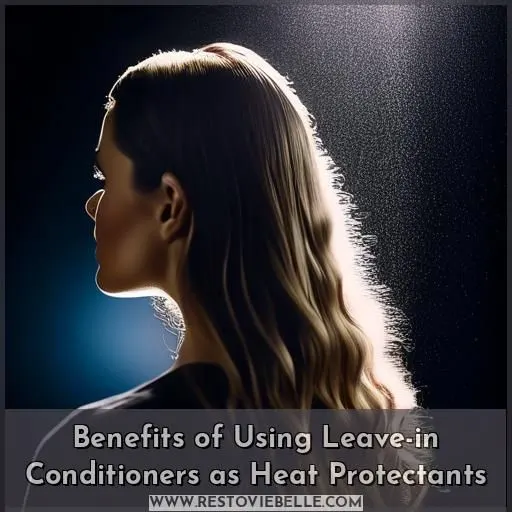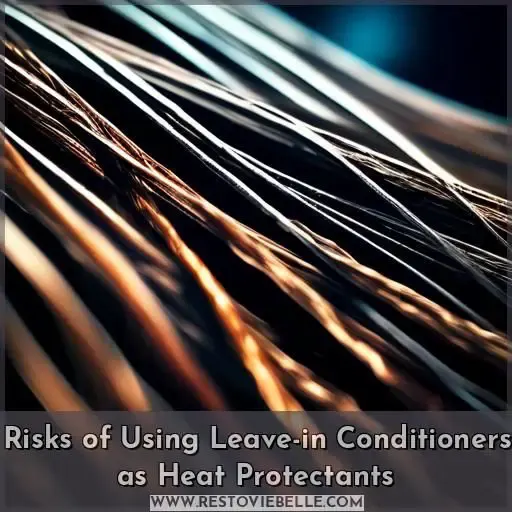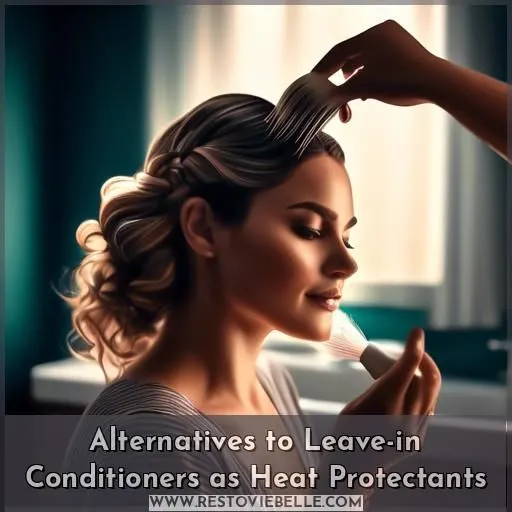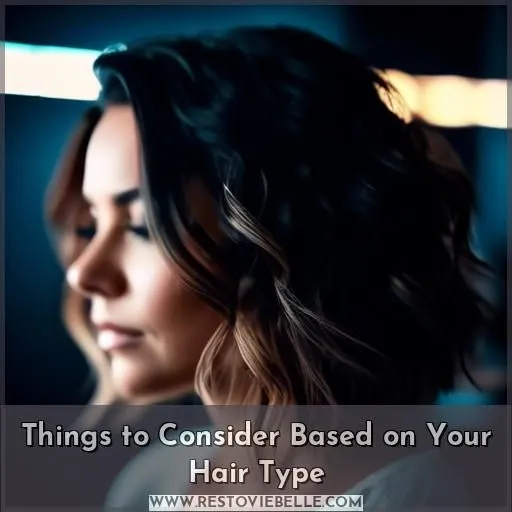This site is supported by our readers. We may earn a commission, at no cost to you, if you purchase through links.
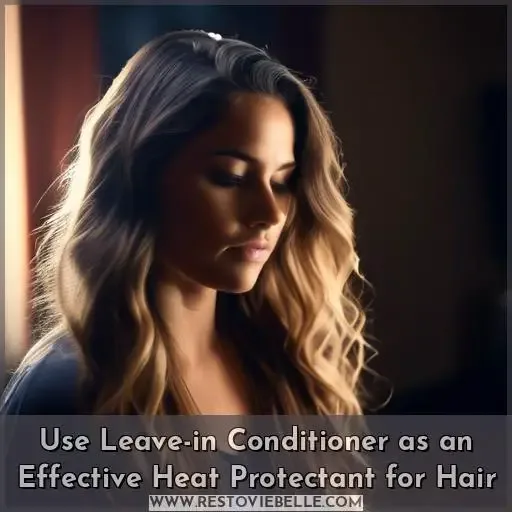
You can absolutely use a leave-in conditioner as an effective heat protectant for your hair. While it may not provide the same level of heat defense as dedicated products, many leave-in formulas contain helpful silicones and ingredients that can shield your strands from the damaging effects of hot styling tools.
Just be sure to check the bottle instructions, apply to damp hair, and comb through evenly. Heat actually enhances the effectiveness of leave-in conditioners as heat protectants. Doing this can protect your hair, add moisture, reduce frizz, and improve manageability.
However, there are some risks to keep in mind as well. Read on to explore the full benefits and considerations.
Table Of Contents
- Key Takeaways
- Can Leave-in Conditioners Protect Hair From Heat Damage?
- How to Use Leave-in Conditioners as Heat Protectants
- Benefits of Using Leave-in Conditioners as Heat Protectants
- Risks of Using Leave-in Conditioners as Heat Protectants
- Alternatives to Leave-in Conditioners as Heat Protectants
- Things to Consider Based on Your Hair Type
- Frequently Asked Questions (FAQs)
- Can all leave-in conditioners be used as heat protectants?
- How does the order of ingredients in a leave-in conditioner affect its heat protection capabilities?
- Can using a leave-in conditioner as a heat protectant cause buildup?
- What are the benefits of using a heat protectant and leave-in conditioner together?
- How does the use of leave-in conditioners as heat protectants vary for different hair types?
- Conclusion
Key Takeaways
- Some leave-in conditioners can act as heat protectants when used as directed and contain silicones that protect against heat damage.
- Heat actually enhances the effectiveness of leave-in conditioners as heat protectants by unlocking hair cuticles and allowing nourishing elements to penetrate deeply.
- Not all leave-in conditioners provide heat protection, so it’s important to check the ingredients and instructions on the bottle before using them as heat protectants.
- Using leave-in conditioners as heat protectants can protect hair from heat damage, add moisture, reduce frizz, and improve manageability, but there are risks such as buildup and greasiness if not used correctly.
Can Leave-in Conditioners Protect Hair From Heat Damage?
Did you know that some leave-in conditioners can actually double as heat protectants? It’s all about checking the instructions on the bottle – certain formulas are made to increase their power when exposed to heat styling.
Some Leave-in Conditioners Can Act as Heat Protectants
Yes, leave-in conditioners can protect hair from heat damage, although not as effectively as dedicated heat protectants. They add moisture to the hair, which makes it less prone to breakage when exposed to high temperatures.
Some leave-in conditioners, like Chi Silk Infusion and Silk2 Penetrating Leave-In Conditioner, can act as heat protectants when used as directed.
However, not all leave-in conditioners provide heat protection, so it’s important to consult the instructions on the bottle before using them as heat protectants.
Check the Instructions on the Bottle
To check if your leave-in conditioner can protect your hair from heat damage, you should examine the ingredients list. Some common silicones that protect against heat include Cetearyl Methicone, Dimethicone, Stearyl Dimethicone, Amodimethicone, and Piperindinyl Dimethicone. These ingredients create a barrier between your hair and the heat source, effectively safeguarding your hair from heat damage.
If your leave-in conditioner contains these ingredients, it could protect your hair from damage caused by heat application. However, not all leave-in conditioners contain these heat-protecting ingredients, so it’s crucial to scrutinize the label carefully before using it as a heat protectant.
Heat Enhances the Effectiveness of These Conditioners
When heat embraces your hair, it’s not just about a superficial encounter. It’s a transformative moment, orchestrated by heat activation. Here’s how it works:
- Strand Penetration: Heat unlocks hair cuticles, granting access to silicones, nutrients, vitamin B, rice protein, and angelica root. These nourishing elements penetrate deeply, safeguarding moisture and preventing damage.
- Moisture Enhancement: This profound absorption traps hydration, rejuvenating dry, brittle strands into supple, radiant locks.
- Styling Efficiency: With each strand thoroughly strengthened, your hair not only resists the heat’s effects but also styles effortlessly, turning heat from an adversary into an ally in your beauty regimen.
Not All Leave-in Conditioners Provide Heat Protection
Not all leave-in conditioners provide heat protection, as they’re primarily formulated to moisturize and nourish hair. While they can help protect the hair against heat damage by adding moisture, they aren’t designed to withstand high temperatures like dedicated heat protectants.
If you’re looking for a product that can act as both a leave-in conditioner and a heat protectant, you should consider using a product specifically designed for that purpose or consult with a hair stylist for personalized recommendations.
How to Use Leave-in Conditioners as Heat Protectants
Before using a leave-in conditioner as a heat protectant, be sure to read the instructions on the bottle. Apply the leave-in conditioner evenly through damp hair, combing it through to make sure it’s spread evenly.
Read the Instructions on the Bottle
To use leave-in conditioners as heat protectants, it’s essential to familiarize yourself with the instructions on the bottle. This guarantees alignment with your hair type and the intended results. Consistency in application is paramount, as the duration can influence the temperature of the hair.
Always precede the application of the leave-in conditioner with a heat protectant spray, like hair love prep spray.
Bear in mind that while an amethyst crystal may elevate your hair routine with a luxurious touch, it lacks the capacity to safeguard your hair from heat damage.
Apply the Leave-in Conditioner to Damp Hair
To apply leave-in conditioner as a heat protectant, follow these steps:
- Determine compatibility: Not all leave-in conditioners are compatible with heat protection. Check the product’s ingredients and the instructions on the bottle to confirm it contains heat-protecting ingredients like silicones.
- Apply to damp hair: Spray the leave-in conditioner onto damp hair before styling. This allows the product to disperse evenly and create a barrier to safeguard your hair from heat damage.
- Comb through: After applying the leave-in conditioner, use a wide-tooth comb or brush to ensure even distribution throughout your hair. This helps prevent any tangles or knots that could cause damage during styling.
- Allow hair to air dry: If possible, let your hair air dry after applying the leave-in conditioner. This allows the product to fully penetrate the hair shaft and provide maximum protection.
- Use a heat protectant setting: If you must use a blow dryer, choose one with a heat protectant setting to minimize heat damage. This setting helps maintain the protective barrier provided by the leave-in conditioner.
Comb Through Hair to Ensure Even Distribution
To guarantee equitable distribution of a leave-in conditioner when employing it as a heat protectant, adhere to these measures:
- Subsequent to applying the leave-in conditioner to moist hair, employ a wide-tooth comb to cautiously disentangle your hair, commencing from the ends and progressing to the roots.
- Comb through your hair in diminutive sections, exercising caution to refrain from pulling or tugging at your hair excessively.
- Upon completion of combing through your entire head, permit your hair to air dry or utilize a blow dryer equipped with a heat protectant setting.
Benefits of Using Leave-in Conditioners as Heat Protectants
Using leave-in conditioner as a heat protectant can provide numerous benefits for your hair. It shields your locks from heat damage, adds essential moisture, and reduces frizz and flyaways, leaving your hair more manageable and healthier overall.
Protects Hair From Heat Damage
After effortlessly switching from detangling, your leave-in conditioner emerges as a protector, shielding your hair from the harsh effects of heat styling tools. It’s a wise product selection, customized to your hair type, that prevents heat damage.
Adds Moisture to Hair
By adding moisture to your hair, leave-in conditioners can enhance its overall health. They help in hydrating the follicles and protecting the scalp. Using a compatible leave-in conditioner as a heat protectant can ensure product compatibility and safeguard your hair from damage.
Reduces Frizz and Flyaways
Using leave-in conditioners as heat protectants can be a great way to reduce frizz and flyaways in your hair. Here are four ways to maximize their effectiveness:
- Choose the right product: Not all leave-in conditioners are designed to provide heat protection. Look for products that specifically mention thermal protection or heat damage prevention in their features.
- Apply correctly: Follow the instructions on the bottle. Generally, apply the leave-in conditioner to damp hair and comb through to guarantee even distribution. Allow your hair to air dry or use a blow dryer with a heat protectant setting.
- Use in conjunction with a heat protectant: While leave-in conditioners can provide some heat protection, they aren’t as effective as dedicated heat protectants. Use them together for best results.
- Consider your hair type: Different leave-in conditioners may work better for different hair types. For example, those with fine hair may prefer a lightweight leave-in conditioner that doesn’t weigh their hair down, while those with coily hair may benefit from a leave-in conditioner that provides deep conditioning and hydration.
Makes Hair More Manageable
Using a leave-in conditioner as a heat protectant can save you time and effort, as it combines both functions in one product. It provides moisture to your hair, which can help reduce frizz and flyaways, making it more manageable. This cost-effective solution can also help prevent damage from heat styling, giving you a boost in your hair care routine.
Can Improve the Overall Health of Hair
Employing a leave-in conditioner as a heat protectant can substantially enhance the general health of your hair. This method offers both heat protection and conditioning, minimizing product buildup and conserving time.
However, it’s imperative to select the appropriate product and apply it correctly to avert potential risks such as buildup or inadequate heat protection. Consistently consult the instructions on the bottle and take into account the distinct needs of your hair type.
Risks of Using Leave-in Conditioners as Heat Protectants
Be cautious when using leave-in conditioners as heat protectants. Applying too much can weigh down your hair, and using them on dry hair can lead to product buildup and a greasy appearance that may interfere with styling.
Applying Too Much Leave-in Conditioner Can Weigh Hair Down
Going overboard with leave-in conditioner? You’re not alone. It’s like loading your plate at a buffet—tempting but weighs you down. Aiming for buildup reduction and product minimization? Less is more. This approach champions time efficiency and tackles suitability concerns, ensuring your hair type isn’t drowned out by excess.
Using Leave-in Conditioner on Dry Hair Can Cause Buildup
Using leave-in conditioners on dry hair can cause buildup, which is a common issue with these products. When you apply leave-in conditioners to dry hair, they can accumulate on the hair shaft, leading to a heavy, greasy appearance. This is because leave-in conditioners are designed to be used on damp hair to provide extra moisture and conditioning.
To avoid this problem, it’s imperative to follow the instructions on the leave-in conditioner bottle. Some leave-in conditioners are specifically designed to be used on dry hair, while others are best suited for damp hair. If you’re unsure, it’s always a good idea to consult with a hair stylist or do some research to find the best product for your hair type.
Here are three things to keep in mind when using leave-in conditioners on dry hair:
- Choose the right product: Not all leave-in conditioners are suitable for dry hair. Look for products that are specifically designed for dry hair or that have a lightweight formula.
- Avoid overuse: Using too much leave-in conditioner on dry hair can lead to buildup. Stick to the recommended amount and avoid applying the product to your scalp, as this can cause product buildup.
- Rinse your hair: If you notice buildup or a greasy appearance, rinse your hair thoroughly to remove any excess product. This will help prevent damage to your hair and guarantee that your hair stays healthy and manageable.
Can Make Hair Look Greasy
If you’re worried about your hair looking greasy when using a leave-in conditioner as a heat protectant, don’t be. While it’s true that some products can weigh hair down or leave a residue, not all leave-in conditioners are created equal. Look for lightweight formulas that are specifically designed to provide heat protection without causing buildup.
The right leave-in conditioner can actually improve your hair’s health and texture, giving you a more manageable, stylish look.
Can Interfere With Styling Products
As a supportive assistant, I’m here to accompany you through the landscape of hair care. While leave-in conditioners can provide some heat protection, they may not offer the most comprehensive coverage. Furthermore, using a leave-in conditioner as a heat protectant might impede styling products, resulting in accumulation and potential harm to your hair.
To attain the optimal outcomes, consider employing a separate heat protectant or a product that harmonizes both functionalities. Remember that individual hair types and requirements may vary, so it’s crucial to investigate and consult with a hair stylist to discern the most suitable solution for the well-being of your hair.
Alternatives to Leave-in Conditioners as Heat Protectants
If you’re looking for alternatives to using leave-in conditioners as heat protectants, you have several options. Here are five suggestions:
- Heat Protectant Sprays: These are specifically designed to protect hair from heat damage. They can be applied to damp or dry hair and provide a barrier against the heat styling tools.
- Heat Protectant Serums: These lightweight formulas can be applied to damp or dry hair and provide heat protection while also adding shine and manageability.
- Heat Protectant Creams: These creams offer extra moisture and protection for your hair. They can be applied to damp or dry hair and provide a long-lasting barrier against heat damage.
- Heat Protectant Oils: These oils can help seal in moisture and protect hair from heat. They can be applied to damp or dry hair and provide a natural, lightweight alternative to other heat protectants.
- Heat Protectant Styling Products: These products, such as mousses and gels, can provide heat protection while also styling your hair. They can be used on damp or dry hair and offer a more versatile option for those who want to style their hair without compromising its health.
Things to Consider Based on Your Hair Type
When employing a leave-in conditioner as a heat protectant, take into account your particular hair type’s requirements. Choose the most suitable product and application approach to guarantee adequate protection and nourishment for your hair.
Hair Type Needs
Understanding your hair type is like deciphering a secret code to flawless hair. It’s the beacon guiding you through the ocean of leave-in formulas and ingredients, ensuring you don’t stumble upon a hair mishap. Here’s a swift cheat sheet:
| Hair Type | Considerations |
|---|---|
| Fine | Delicate formulas to prevent greasiness |
| Thick | Enriching leave-in advantages for hydration |
| Curly | Leave-in components that accentuate curls |
| Color-treated | Leave-in application to shield color |
Product Selection Tips
After identifying your hair’s requirements, embark on ingredient selection as a vigilant investigator. High porosity? Seek out products that are protein-infused.
For those with a penchant for DIY, delve into homemade mixtures with natural oils. Refrain from selecting products impulsively; meticulously examine labels for recommendations that align with your hair’s characteristics.
Bear in mind, the ideal ingredients can transform your hair care regimen from an obligation into an indulgence, guaranteeing that your tresses remain both healthy and captivating.
Application Techniques
When applying leave-in conditioner as a heat protectant, consider your hair type and styling needs. For finer hair, use a lightweight leave-in conditioner and avoid applying too much product. For thicker hair, opt for a heavier leave-in conditioner that provides more conditioning benefits.
Always read the instructions on the bottle and avoid using leave-in conditioner on dry hair, as this can cause buildup.
For styling considerations, choose a product that offers both heat protection and conditioning benefits, or use separate products if needed. Remember, individual results may vary, so always test out different products and techniques to find what works best for your hair.
Frequently Asked Questions (FAQs)
Can all leave-in conditioners be used as heat protectants?
Only about 1 in 5 leave-in conditioners can double as heat protectants. You’re not out of luck though – look for formulas with silicones, proteins, and heat-activated ingredients to shield strands from hot tools.
How does the order of ingredients in a leave-in conditioner affect its heat protection capabilities?
The order of ingredients in a leave-in conditioner can make all the difference in terms of heat protection. Look for options with silicones and polymers listed first – they’re your heat-shielding superstars.
Can using a leave-in conditioner as a heat protectant cause buildup?
You bet – using the wrong leave-in as a heat protectant can absolutely lead to pesky product buildup. Look for leave-ins specifically formulated to shield hair from heat, or you may end up with a greasy, weighed-down mess.
What are the benefits of using a heat protectant and leave-in conditioner together?
Using a heat protectant and leave-in conditioner together nourishes your hair, shields it from heat damage, and leaves it soft, shiny, and manageable. It’s a dynamic duo that’ll have your locks looking and feeling their best.
How does the use of leave-in conditioners as heat protectants vary for different hair types?
Depending on your hair type, leave-in conditioners may be a treasure trove or a beast of trouble. Curly gals might lock in moisture, while straight-haired beauties may end up weighed down. Listen to your locks and find what works for you.
Conclusion
Unquestionably, the adaptability of leave-in conditioners is nothing less than enchanting. By adhering to the insightful advice provided in this article, you can utilize the potency of these versatile wonders to safeguard your locks from the scorching impact of thermal styling devices.
Bear in mind, with a dash of ingenuity and the appropriate technique, you can employ leave-in conditioner as an efficient heat protector, shielding your hair’s well-being and elevating your styling prowess to unprecedented levels.
Embrace the allure of this dual-purpose delight and allow your tresses to thrive.
